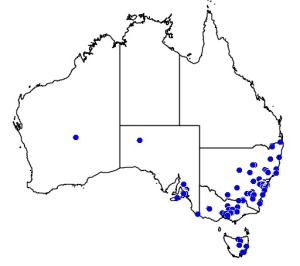Colours
Distinguishing features
The adult is a shiny black above and brown and finely hairy underneath. As the name implies, the eyes are a deep red colour, although pinkish- and brownish-eyed specimens are seen. (Wikipedia)
Size
- Size data has not been obtained.
Wingspan
- From 10 cm to 12 cm
Synonyms
Distribution
Distribution and habitat preferences
Encountered from November to February only, the redeye is found from the New England region of south-east Queensland through New South Wales and into Victoria and south-eastern South Australia, and Eastern and Northern Tasmania. It is found from the coast inland to Toowoomba and Inverell in the north, and the Grampians and Mount Lofty Ranges in the south. It is found at elevation in the northern parts of its range, and at low altitudes in the southern parts. (Wikipedia)
Diet
The redeye prefers open sclerophyll forest, in particular smooth-barked eucalypts and Angophora species, but will settle for rough-barked species if more suitable trees are not available. Species favoured include Sydney Red Gum or Smooth-barked Apple (Angophora costata) around Sydney, Eucalyptus grandis in the vicinity of Taree, Manna Gum (Eucalyptus viminalis), and Eucalyptus obliqua near Adelaide. It has also settled for introduced trees such as the liquidambar (Liquidambar styraciflua), Japanese Maple (Acer palmatum), and Weeping Willow (Salix babylonica). Redeyes settle on the trunks of smoother barked trees, and wherever the bark is smoothest on rougher trees, and may gather in large numbers on some trees while ignoring others nearby. (Wikipedia)
They puncture the bark and may feed for hours at a time. They expel waste fluid which can fall in a constant shower if there are large numbers of redeyes.







